Two-Stage Super-Efficiency Slacks-Based Model to Assess China’s Ecological Wellbeing
Abstract
:1. Introduction
2. Literature Review
3. Methodology
3.1. Selection of Input-Output Indicators
3.1.1. Input Indicators
3.1.2. Output Indicators
3.2. Assessment Model
3.3. Data Collection
4. Empirical Analysis
4.1. Overall EWP Analysis
4.1.1. Comprehensive EWP Level
4.1.2. Two Stage Performance
4.2. EWP Temporal Analysis
4.2.1. Provincial Perspective
4.2.2. Regional perspective
4.3. EWP Spatial Analysis
4.3.1. EWP Spatial pattern
4.3.2. Spatial Correlation Analysis
5. Conclusions
Author Contributions
Funding
Conflicts of Interest
References
- National Bureau of Statistics. National Bureau of Statistics of the People’s Republic of China. Available online: http://www.stats.gov.cn/tjsj/zxfb/202002/t20200228_1728913.html (accessed on 28 February 2020).
- Bian, J.; Zhang, Y.; Shuai, C.; Shen, L.; Ren, H.; Wang, Y. Have cities effectively improved ecological well-being performance? Empirical analysis of 278 Chinese cities. J. Clean. Prod. 2020, 245, 118913. [Google Scholar] [CrossRef]
- Zhang, Y.; Chen, X.; Wu, Y.; Shuai, C.; Shen, L. The environmental Kuznets curve of CO2 emissions in the manufacturing and construction industries: A global empirical analysis. Environ. Impact Assess. Rev. 2019, 79, 106303. [Google Scholar] [CrossRef]
- Gao, S.; Sun, H.; Cao, G.; Zhao, L.; Xu, M. Dynamic state of ecosystem carrying capacity under island urbanization: A case study of pingtan island in the southeastern coast of china. J. Environ. Eng. Landsc. Manag. 2020, 28, 1–8. [Google Scholar] [CrossRef] [Green Version]
- BP. BP Statistical Review of World Energy. Available online: https://www.bp.com/content/dam/bp/business-sites/en/global/corporate/pdfs/energy-economics/statistical-review/bp-stats-review-2020-full-report.pdf (accessed on 25 September 2020).
- Li, H.; Yu, L. Chinese eco-city indictor construction. Urban Stud. 2011, 18, 81–86. [Google Scholar]
- Huo, T.; Ren, H.; Cai, W. Estimating urban residential building-related energy consumption and energy intensity in China based on improved building stock turnover model. Sci. Total Environ. 2019, 650, 427–437. [Google Scholar] [CrossRef]
- Bian, J.; Ren, H.; Liu, P. Evaluation of urban ecological well-being performance in China: A case study of 30 provincial capital cities. J. Clean. Prod. 2020, 254, 120109. [Google Scholar] [CrossRef]
- Feng, Y.; Zhong, S.; Li, Q.; Zhao, X.; Dong, X. Ecological well-being performance growth in China (1994–2014): From perspectives of industrial structure green adjustment and green total factor productivity. J. Clean. Prod. 2019, 236, 117556. [Google Scholar] [CrossRef]
- Daly, H.E. The world dynamics of economic growth: The economics of the steady state. Am. Econ. Rev. 1974, 64, 15–23. [Google Scholar]
- Redclift, M. Sustainable development (1987–2005): An oxymoron comes of age. Sustain. Dev. 2005, 13, 212–227. [Google Scholar] [CrossRef] [Green Version]
- Redclift, M. Sustainable development: Needs, values, rights. Environ. Values 1993, 2, 3–20. [Google Scholar] [CrossRef] [Green Version]
- Beckerman, W. ‘Sustainable development’: Is it a useful concept? Environ. Values 1994, 3, 191–209. [Google Scholar] [CrossRef] [Green Version]
- Rees, W.E. Ecological footprints and appropriated carrying capacity: What urban economics leaves out. Environ. Urban. 1992, 4, 121–130. [Google Scholar] [CrossRef]
- Daly, H.E.; Cobb, J.B. For the Common Good: Redirecting the Economy toward Community, the Environment and a Sustainable Future; Beacon Press: Boston, MA, USA, 1989. [Google Scholar]
- Veenhoven, R. World database of happiness. Soc. Indicat. Res. 1995, 34, 299–313. [Google Scholar] [CrossRef] [Green Version]
- Sen, A. Capability and well-being. In The Quality of Life; Nussbaum, M., Sen, A., Eds.; Oxford Scholarship Press: Oxford, OH, USA, 1993; pp. 30–53. [Google Scholar]
- Common, M. Measuring national economic performance without using prices. Ecol. Econ. 2007, 64, 92–102. [Google Scholar] [CrossRef]
- Schneider, T.; Badii, R. The happy planet index 2.0: Why good lives don’t have to cost the Earth. New Econ. Found. 2009, 18, L187–L193. [Google Scholar]
- Dietz, T.; Rosa, E.A.; York, R. Environmentally efficient well-being: Is there a Kuznets curve? Appl. Geogr. 2012, 32, 21–28. [Google Scholar] [CrossRef]
- Chen, P.; Xie, R.; Lu, M. “Resource conservation” or “environmental friendliness”: How do urban clusters affect total-factor ecological performance in China? Int. J. Environ. Res. Public Health 2020, 17, 4361. [Google Scholar] [CrossRef] [PubMed]
- Moran, D.D.; Wackernagel, M.; Kitzes, J.A.; Goldfinger, S.H.; Boutaud, A. Measuring sustainable development—nation by nation. Ecol. Econ. 2008, 64, 470–474. [Google Scholar] [CrossRef]
- Dietz, T.; Rosa, E.A.; York, R. Environmentally efficient well-being: Rethinking sustainability as the relationship between human well-being and environmental impacts. Hum. Ecol. Rev. 2009, 16, 114–123. [Google Scholar]
- Knight, K.; Rosa, E. The environmental efficiency of Well-being: Across national analysis. Soc. Sci. Res. 2011, 40, 931–949. [Google Scholar] [CrossRef]
- Jorgenson, A.K.; Alekseyko, A.; Giedraitis, V. Energy consumption, human well-being and economic development in central and eastern European nations: A cautionary tale of sustainability. Energy Policy 2014, 66, 419–427. [Google Scholar] [CrossRef]
- Zhu, D.; Zhang, S.; Sutton, D.B. Linking Daly’s proposition to policymaking for sustainable development: Indicators and pathways. J. Clean. Prod. 2015, 102, 333–341. [Google Scholar] [CrossRef]
- Zhang, S.; Zhu, D.; Shi, Q.; Cheng, M. Which countries are more ecologically efficient in improving human well-being? An application of the index of ecological well-being performance. Resour. Conserv. Recycl. 2018, 129, 112–119. [Google Scholar] [CrossRef]
- Feng, J.; Yuan, J. On Chinese regional ecological well-being performance and its influence factors. Forum. Sci. Technol. China 2016, 3, 100–105. [Google Scholar]
- Xu, Y.; Qi, P.; Tong, L. Spatial-temporal differentiation of Chinese provincial ecological well-being performance. Reg. Econ. Rev. 2017, 4, 123–131. [Google Scholar]
- Xiao, L.; Zhang, X. Spatio-temporal characteristics of coupling coordination between green innovation efficiency and ecological welfare performance under the concept of strong sustainability. J. Nat. Resour. 2019, 34, 312–324. [Google Scholar]
- Fang, S.; Xiao, Q. Research on regional ecological well-being performance and spatial effect in China. China Popul. Resour. Environ. 2019, 29, 1–10. [Google Scholar]
- He, L.; Chen, X. Study on sustainable economic development of Shaanxi province based on ecological well-being. Res. Dev. 2011, 6, 24–28. [Google Scholar]
- Long, L.; Wang, X. A study on Shanghai’s ecological well-being performance. China Popul. Resour. Environ. 2017, 27, 84–92. [Google Scholar]
- Long, L. Evaluation of urban ecological well-being performance of Chinese major cities based on two-stage super-efficiency network SBM Model. China Popul. Resour. Environ. 2019, 29, 1–10. [Google Scholar]
- Daly, H.E. Economics in a full world. Sci. Am. 2005, 293, 100–107. [Google Scholar] [CrossRef] [PubMed]
- Zhu, D.; Qiu, S. Ecological efficiency is a suitable measure of circular economy. China Popul. Resour. Environ. 2016, 16, 1–6. [Google Scholar]
- Yan, L.; Qu, Z.; Huang, L. Study on the efficiency of ecological capital in the perspective of economic green transformation. China Popul. Resour. Environ. 2013, 23, 18–23. [Google Scholar]
- Bai, Y.; Deng, X.; Jiang, S.; Zhang, Q.; Wang, Z. Exploring the relationship between urbanization and urban eco-efficiency: Evidence from prefecture-level cities in China. J. Clean. Prod. 2018, 195, 1487–1496. [Google Scholar] [CrossRef]
- Charnes, A.; Cooper, W.W.; Rhodes, E. Measuring the efficiency of decision making units. Eur. J. Oper. Res. 1978, 2, 429–444. [Google Scholar] [CrossRef]
- Li, Z.; Ouyang, X.; Du, K.; Zhao, Y. Does government transparency contribute to improved eco-efficiency performance? An empirical study of 262 cities in China. Energy Policy 2017, 110, 79–89. [Google Scholar] [CrossRef]
- Hou, J.; Lv, J.; Chen, X.; Yu, S. China’s regional social vulnerability to geological disasters: Evaluation and spatial characteristics analysis. Nat. Hazards 2016, 84, 97–111. [Google Scholar] [CrossRef]
- Hu, Z.; Zhao, Z.; Zhang, Y.; Jing, H.; Gao, S.; Fang, J. Does ‘Forage-Livestock Balance’ policy impact ecological efficiency of grasslands in China? J. Clean. Prod. 2019, 207, 343–349. [Google Scholar] [CrossRef]
- Tone, K. A slacks-based measure of efficiency in data envelopment analysis. Eur. J. Oper. Res. 2001, 130, 498–509. [Google Scholar] [CrossRef] [Green Version]
- Tone, K.; Tsutsui, M. Dynamic DEA: A slacks-based measure approach. Omega 2010, 38, 145–156. [Google Scholar] [CrossRef] [Green Version]
- Dewarlo, O. DEA window analysis for measuring port performances efficiency of four islands countries located in west Indian ocean countries. Am. J. Ind. Busi. Manag. 2019, 9, 2098–2111. [Google Scholar] [CrossRef] [Green Version]
- Charnes, A.; Clark, C.T.; Cooper, W.W.; Golany, B. A developmental study of data envelopment analysis in measuring the efficiency of maintenance units in the U.S. air forces. Ann. Oper. Res. 1984, 2, 95–112. [Google Scholar] [CrossRef]
- SCPRC. Implementation Opinions on Promoting Ecological Protection and Green Development of Ecological Conservation Areas. Available online: http://www.gov.cn/xinwen/2018-11/06/content_5337816.htm (accessed on 11 March 2020).
- National Bureau of Statistics. Yearbook of National Bureau of Statistics; China Statistics Press: Beijing, China, 2011.
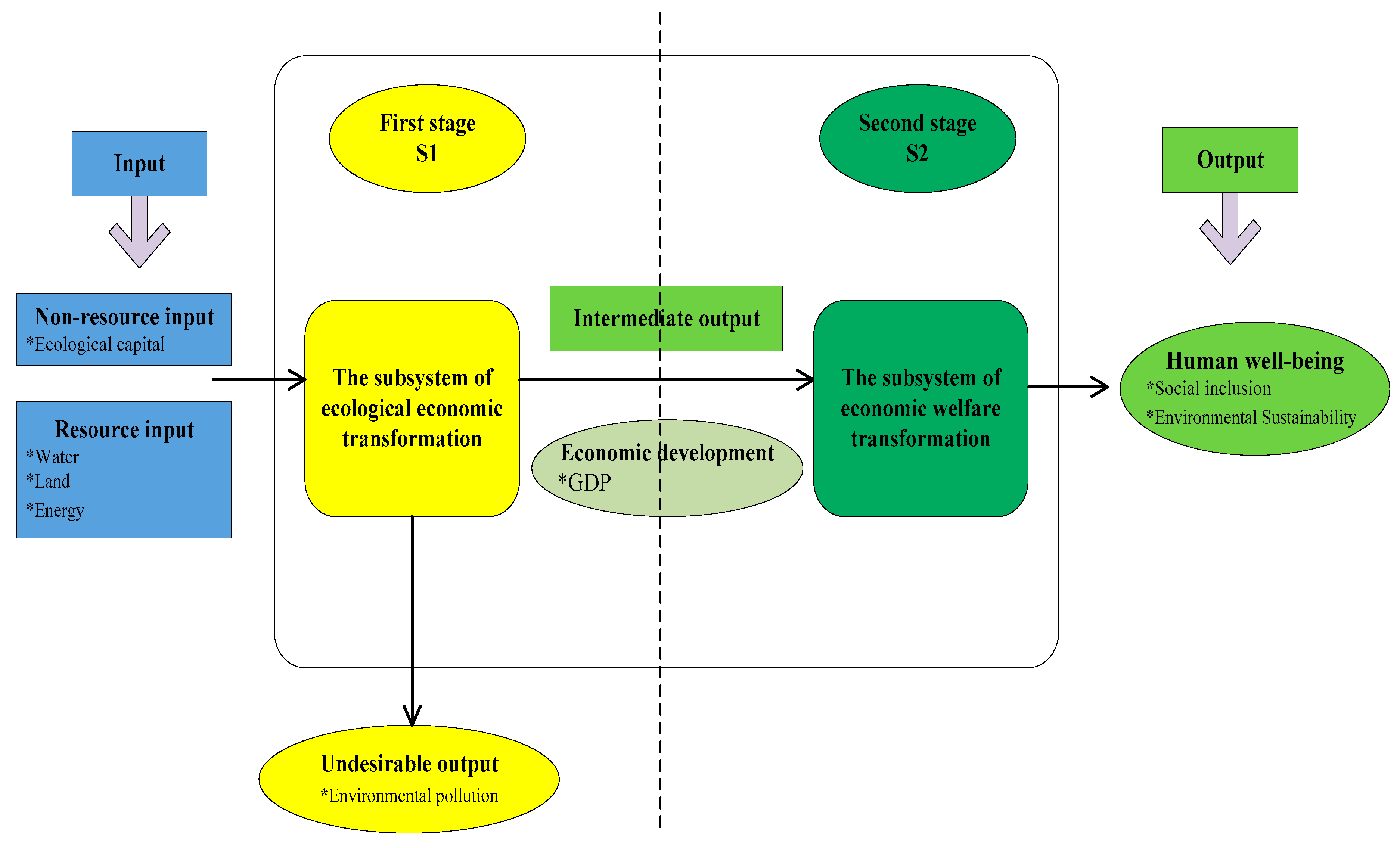

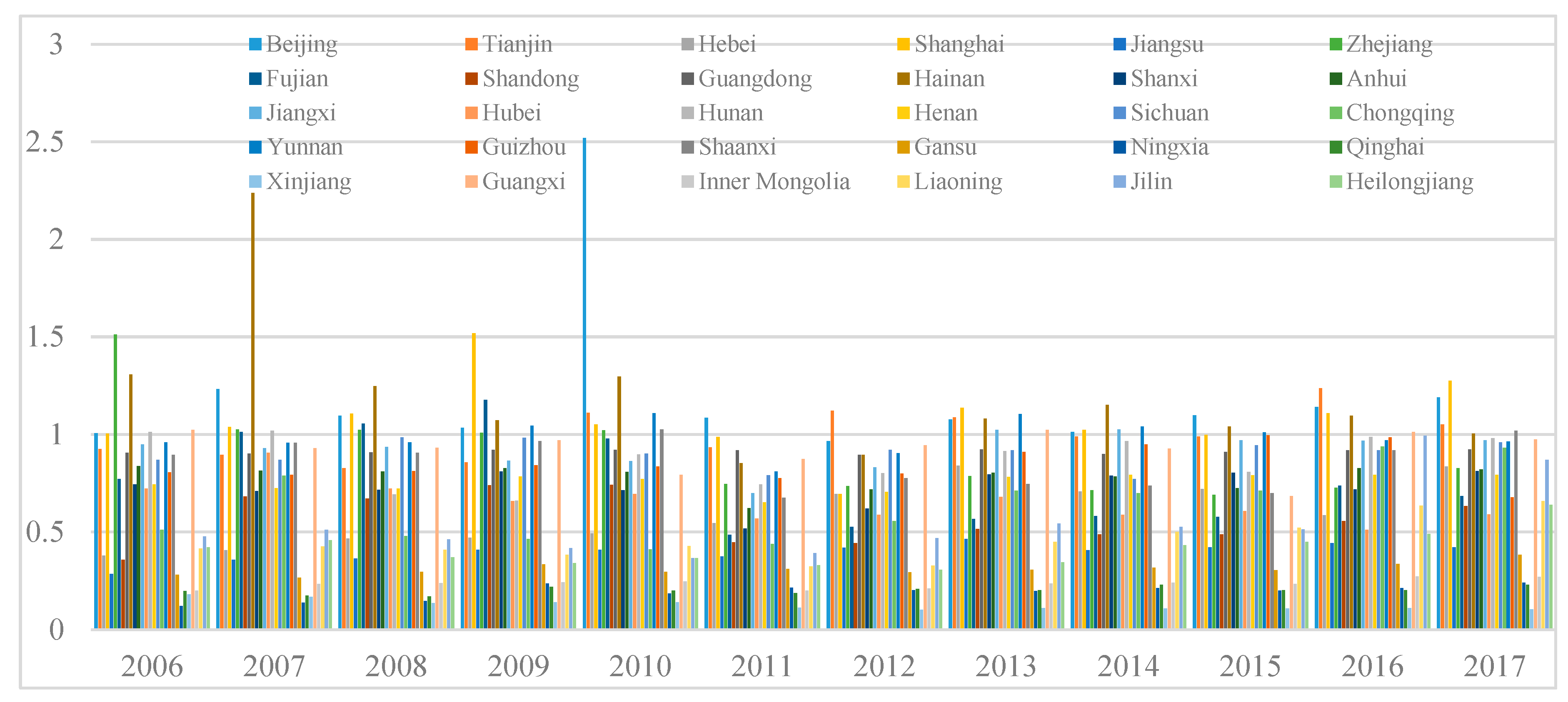

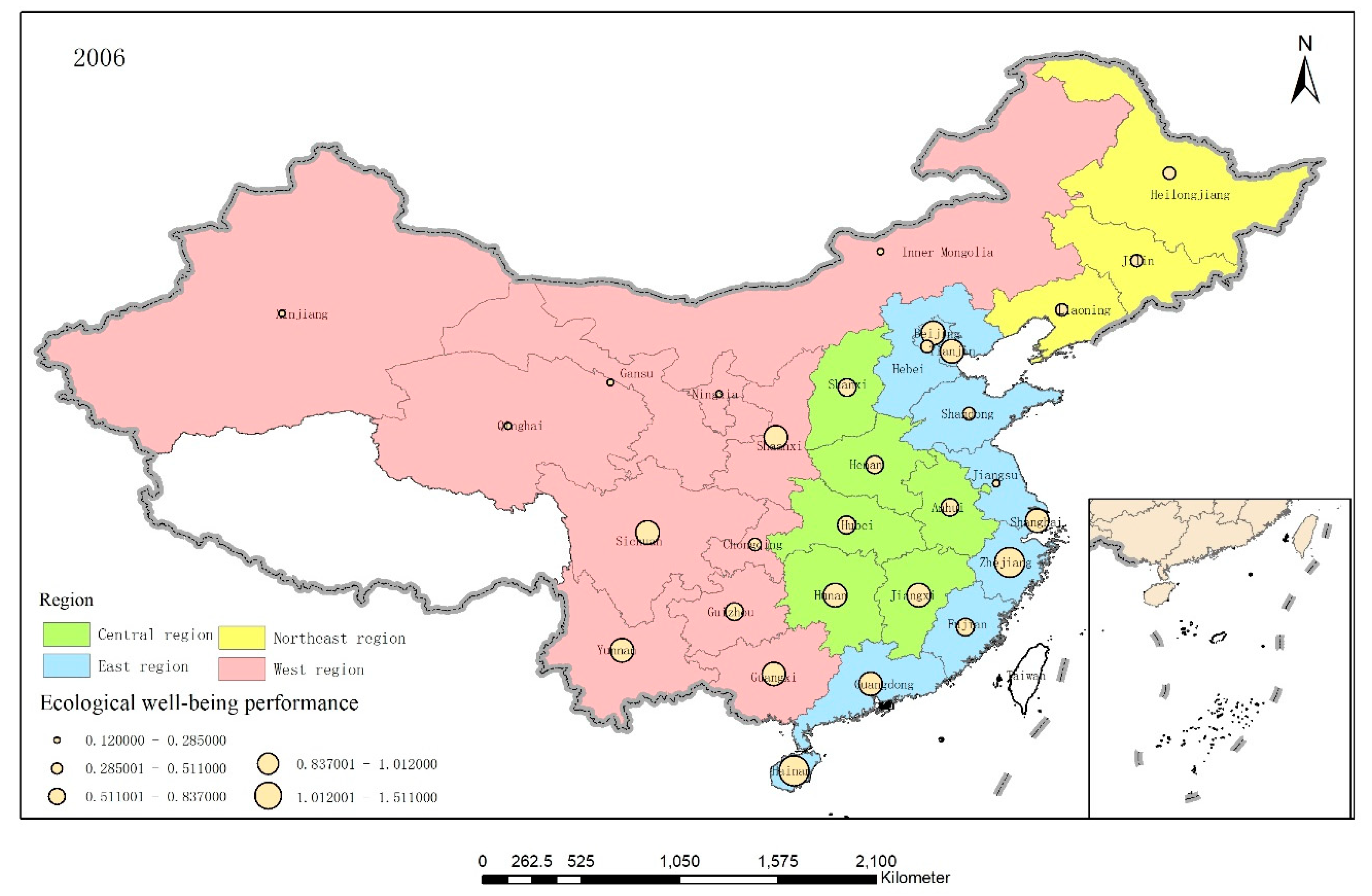

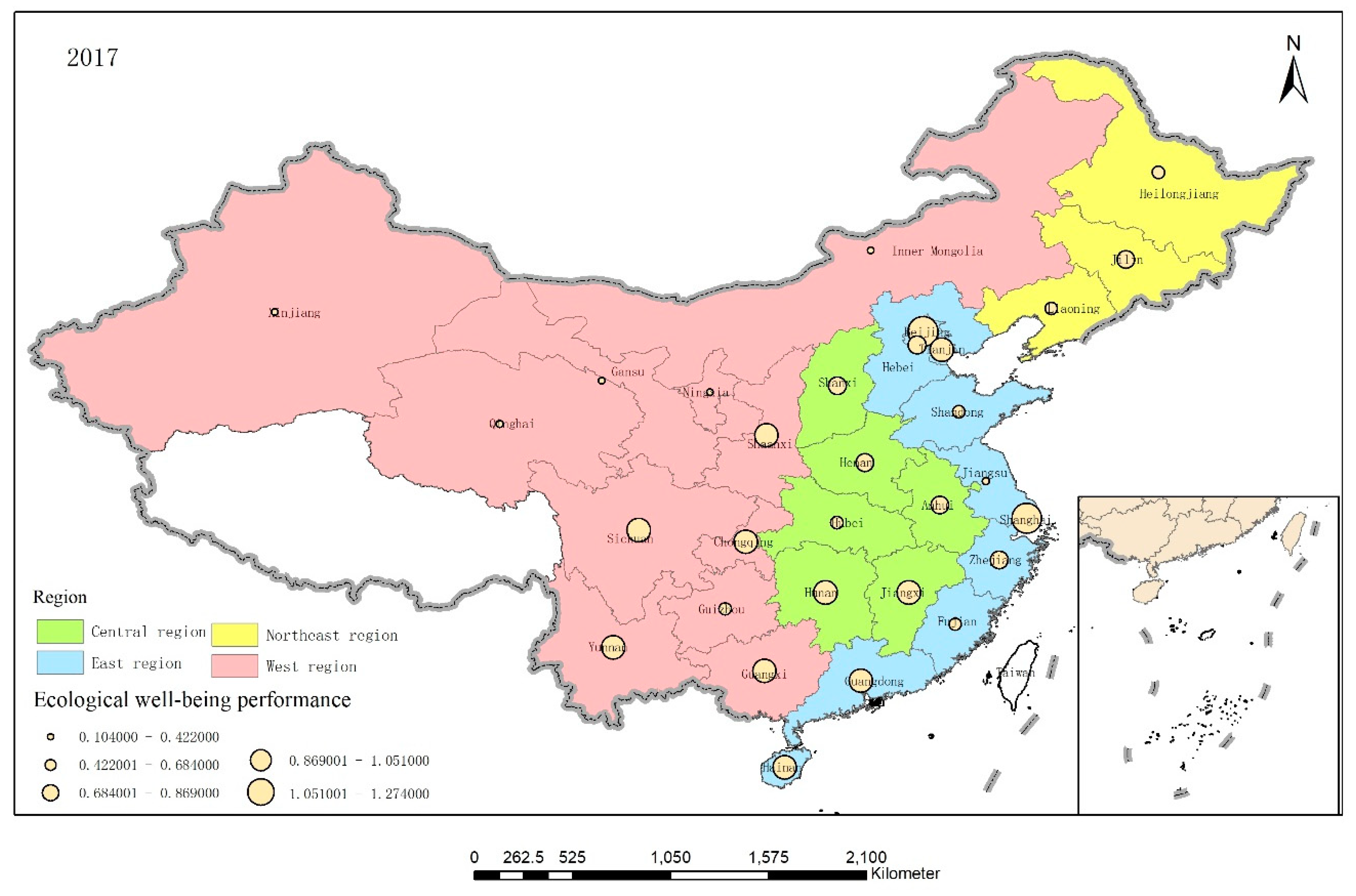
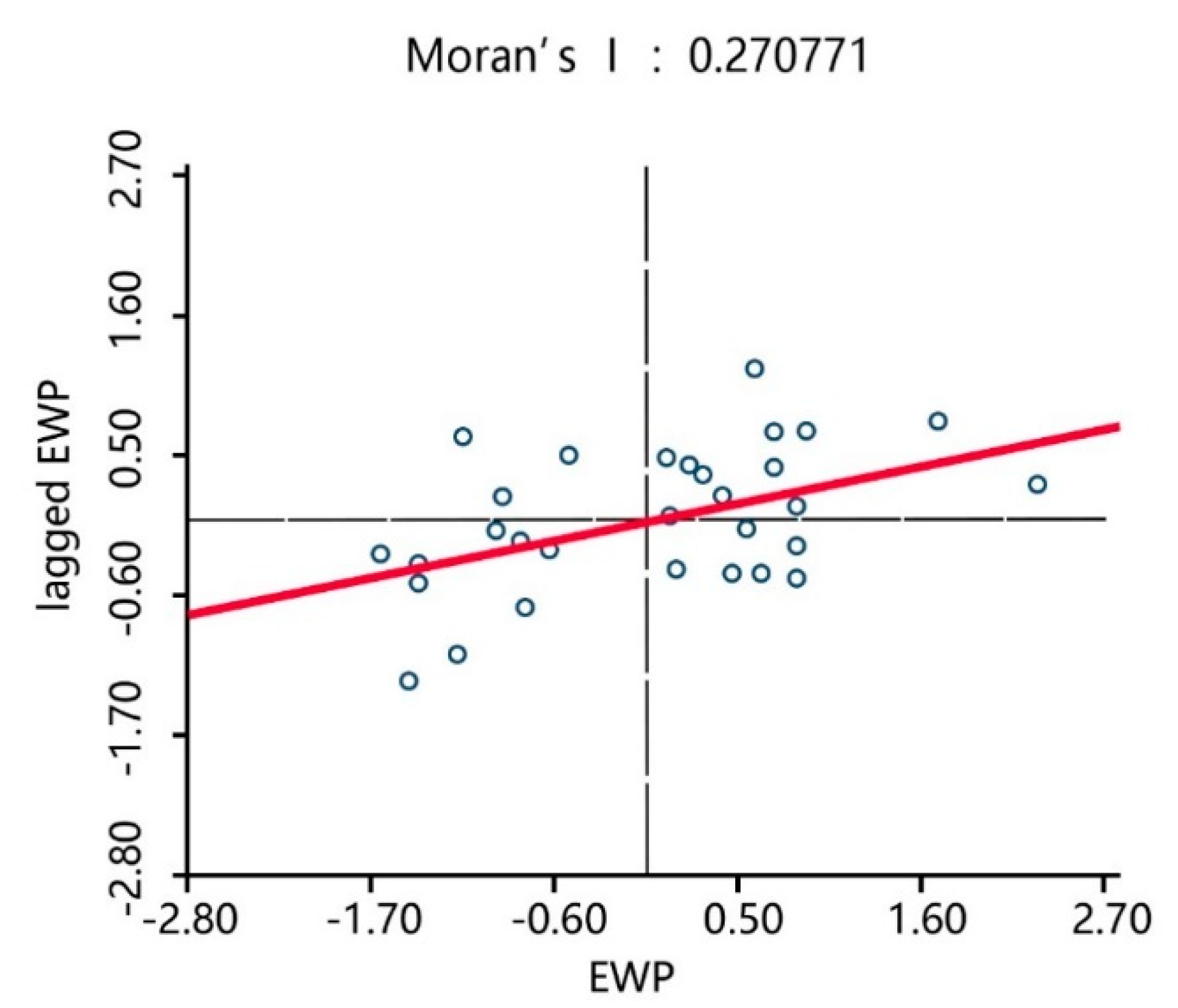
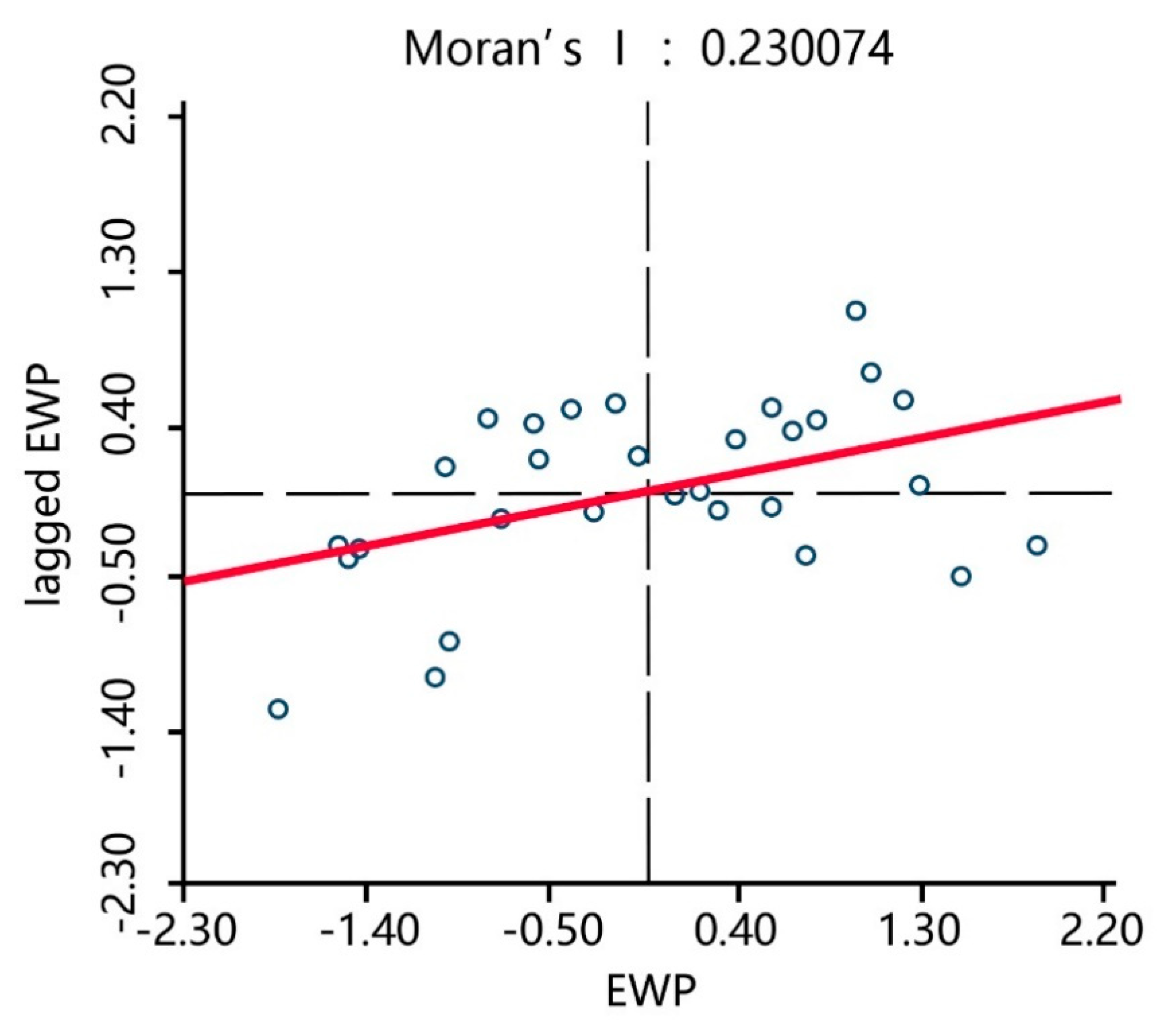

| Scale | Authors | Method | Objective Area | Time Period |
|---|---|---|---|---|
| National level | Common (2007) [18] | The ratio of happiness adjusted life expectancy for the average individual to per capita energy consumption | 75 nations | 1995–2005 |
| Moran et al. (2008) [22] | The ratio of human development index (HDI) to the ecological footprint | 93 countries | 1975–2003 | |
| Dietz et al. (2009) [23] | A Stochastic Frontier Production model | 135 countries | 1999 | |
| Knight and Rosa (2011) [24] | Regress the average life satisfaction and the ecological footprint per capita | 105 countries | 2005 | |
| Dietz et al. (2012) [20] | The ratio of environmental stress to wellbeing | 58 nations | 1961–2003 | |
| Jorgenson et al. (2014) [25] | The adjusted ratio of per capita energy consumption to average life expectancy | 12 European countries | 1992–2010 | |
| Zhu et al. (2015) [26] | The ratio of HDI to ecological footprint | G20 countries | 1995–2008 | |
| Zhang et al. (2018) [27] | The ratio of HDI to per capita normalized ecological footprint | 82 countries | 2012 | |
| Regional level | Feng and Yuan (2016) [28] | The ratio of HDI to normalized per capita ecological footprint | 30 provinces in China | 2005–2010 |
| Xu et al. (2017) [29] | Exploratory Spatial Data Analysis method | 30 provinces in China | 2005–2014 | |
| Xiao and Zhang (2019) [30] | Improved Stochastic Frontier Analysis model | 30 provinces of China | 2004–2015 | |
| Fang and Xiao (2019) [31] | Super-DEA | 30 provinces of China | 2005–2016 | |
| Feng et al. (2019) [9] | The ratio of HDI to Ecological Footprint | 30 provinces of China | 1994–2014 | |
| Individual cities | He and Chen (2011) [32] | The ratio of HDI to per capita ecological footprint index | Shannxi province | 1990–2009 |
| Long and Wang (2017) [33] | Super-slack-based measure (Super-SBM) | Shanghai city | 2006–2014 | |
| Long (2019) [34] | Super-efficiency network SBM model | 35 major cities in China | 2011–2015 | |
| Bian, Ren & Liu (2020) [8] | Super-SBM | 30 provincial capital cities in China | 2011–2016 | |
| Bian et al. (2020) [2] | Super-SBM | 278 Chinese cities | 2005–2016 |
| Category | 1st Tier Indicators | 2nd Tier Indicators | 3rd Tier Indicators |
|---|---|---|---|
| Input Indicators | Ecological capital | Ecological service capital | Ratio of investment in urban environmental infrastructure construction to regional GDP |
| Ecological environment capital | Ratio of total investment in environmental pollution control to GDP | ||
| Ecological resource capital | Ratio of forestry investment completed in the current year to regional GDP | ||
| Consumption of ecological resources | Energy consumption | Per capita energy consumption (tonnes of standard coal/person) | |
| Land resource consumption | Per capita builtup area (km2/10,000 people) | ||
| Water resource consumption | Per capita water consumption (m3/person) | ||
| Undesirable output | Environmental pollution | Wastewater discharge | Per capita chemical oxygen demand (tonnes/person) |
| Per capita ammonia nitrogen emissions (tonnes/person) | |||
| Exhaust gas discharge | Per capita sulfur dioxide emissions (tonnes/person) | ||
| Per capita smoke (powder) dust emission (tonnes/person) | |||
| Solid waste discharge | Per capita production of industrial solid waste (tonnes/person) | ||
| Per capita amount of municipal solid waste (tonnes/person) | |||
| Desirable Output | Economic development | Technological innovation | R&D input as a proportion of GDP |
| Social welfare | Social Inclusion | Urban registered unemployment rate at the end of the year | |
| Environmental Sustainability | Average education (years) | ||
| Number of health technicians per 1000 population | |||
| Forest coverage |
| Region | Provinces | 2006 | 2007 | 2008 | 2009 | 2010 | 2011 | 2012 | 2013 | 2014 | 2015 | 2016 | 2017 | Average | Rank |
|---|---|---|---|---|---|---|---|---|---|---|---|---|---|---|---|
| East region | Beijing | 1.006 | 1.232 | 1.096 | 1.034 | 2.519 | 1.084 | 0.965 | 1.077 | 1.012 | 1.097 | 1.141 | 1.190 | 1.204 | 1 |
| Tianjin | 0.925 | 0.894 | 0.826 | 0.857 | 1.110 | 0.934 | 1.120 | 1.086 | 0.988 | 0.989 | 1.237 | 1.051 | 1.002 | 4 | |
| Hebei | 0.379 | 0.408 | 0.465 | 0.471 | 0.492 | 0.544 | 0.694 | 0.840 | 0.708 | 0.720 | 0.585 | 0.834 | 0.595 | 20 | |
| Shanghai | 1.004 | 1.038 | 1.106 | 1.518 | 1.051 | 0.986 | 0.694 | 1.135 | 1.022 | 0.997 | 1.108 | 1.274 | 1.078 | 3 | |
| Jiangsu | 0.285 | 0.358 | 0.365 | 0.409 | 0.409 | 0.376 | 0.420 | 0.463 | 0.406 | 0.421 | 0.443 | 0.422 | 0.398 | 25 | |
| Zhejiang | 1.511 | 1.026 | 1.023 | 1.008 | 1.020 | 0.745 | 0.734 | 0.785 | 0.713 | 0.690 | 0.726 | 0.827 | 0.901 | 10 | |
| Fujian | 0.772 | 1.013 | 1.054 | 1.177 | 0.977 | 0.486 | 0.526 | 0.566 | 0.582 | 0.577 | 0.736 | 0.684 | 0.763 | 15 | |
| Shandong | 0.358 | 0.682 | 0.670 | 0.740 | 0.741 | 0.446 | 0.443 | 0.514 | 0.487 | 0.488 | 0.555 | 0.632 | 0.563 | 21 | |
| Guangdong | 0.906 | 0.901 | 0.907 | 0.921 | 0.921 | 0.918 | 0.895 | 0.923 | 0.900 | 0.909 | 0.919 | 0.922 | 0.912 | 8 | |
| Hainan | 1.306 | 2.237 | 1.246 | 1.071 | 1.297 | 0.853 | 0.894 | 1.081 | 1.150 | 1.039 | 1.095 | 1.003 | 1.189 | 2 | |
| Central region | Shanxi | 0.743 | 0.709 | 0.716 | 0.809 | 0.713 | 0.518 | 0.620 | 0.795 | 0.789 | 0.802 | 0.718 | 0.811 | 0.729 | 17 |
| Anhui | 0.837 | 0.813 | 0.809 | 0.826 | 0.807 | 0.622 | 0.718 | 0.802 | 0.783 | 0.725 | 0.826 | 0.819 | 0.782 | 14 | |
| Jiangxi | 0.949 | 0.929 | 0.935 | 0.865 | 0.862 | 0.698 | 0.831 | 1.022 | 1.026 | 0.969 | 0.968 | 0.970 | 0.919 | 7 | |
| Hubei | 0.722 | 0.906 | 0.722 | 0.658 | 0.695 | 0.569 | 0.587 | 0.680 | 0.587 | 0.606 | 0.511 | 0.590 | 0.653 | 18 | |
| Hunan | 1.012 | 1.018 | 0.691 | 0.661 | 0.897 | 0.744 | 0.800 | 0.913 | 0.965 | 0.807 | 0.986 | 0.981 | 0.873 | 11 | |
| Henan | 0.743 | 0.724 | 0.722 | 0.784 | 0.770 | 0.651 | 0.705 | 0.781 | 0.792 | 0.790 | 0.792 | 0.792 | 0.754 | 16 | |
| West region | Sichuan | 0.869 | 0.869 | 0.985 | 0.982 | 0.901 | 0.790 | 0.921 | 0.919 | 0.772 | 0.943 | 0.919 | 0.959 | 0.902 | 9 |
| Chongqing | 0.511 | 0.788 | 0.479 | 0.463 | 0.411 | 0.438 | 0.555 | 0.712 | 0.698 | 0.712 | 0.938 | 0.932 | 0.637 | 19 | |
| Yunnan | 0.958 | 0.956 | 0.959 | 1.044 | 1.108 | 0.809 | 0.904 | 1.104 | 1.039 | 1.010 | 0.970 | 0.963 | 0.985 | 5 | |
| Guizhou | 0.805 | 0.793 | 0.812 | 0.841 | 0.834 | 0.776 | 0.798 | 0.909 | 0.948 | 0.995 | 0.985 | 0.678 | 0.848 | 13 | |
| Shaanxi | 0.894 | 0.956 | 0.905 | 0.965 | 1.024 | 0.674 | 0.775 | 0.745 | 0.736 | 0.699 | 0.918 | 1.018 | 0.859 | 12 | |
| Gansu | 0.281 | 0.266 | 0.296 | 0.334 | 0.296 | 0.312 | 0.293 | 0.307 | 0.318 | 0.305 | 0.336 | 0.384 | 0.311 | 26 | |
| Ningxia | 0.120 | 0.138 | 0.146 | 0.236 | 0.184 | 0.215 | 0.202 | 0.197 | 0.212 | 0.199 | 0.213 | 0.241 | 0.192 | 29 | |
| Qinghai | 0.197 | 0.175 | 0.171 | 0.220 | 0.199 | 0.188 | 0.208 | 0.203 | 0.230 | 0.203 | 0.203 | 0.229 | 0.202 | 28 | |
| Xinjiang | 0.180 | 0.168 | 0.136 | 0.140 | 0.140 | 0.113 | 0.102 | 0.110 | 0.109 | 0.108 | 0.110 | 0.104 | 0.126 | 30 | |
| Guangxi | 1.023 | 0.928 | 0.931 | 0.970 | 0.793 | 0.874 | 0.943 | 1.023 | 0.927 | 0.683 | 1.012 | 0.974 | 0.923 | 6 | |
| Inner Mongolia | 0.201 | 0.235 | 0.238 | 0.243 | 0.247 | 0.200 | 0.210 | 0.237 | 0.241 | 0.235 | 0.272 | 0.271 | 0.236 | 27 | |
| Northeast region | Liaoning | 0.415 | 0.427 | 0.410 | 0.384 | 0.428 | 0.324 | 0.329 | 0.449 | 0.499 | 0.521 | 0.634 | 0.657 | 0.456 | 23 |
| Jilin | 0.476 | 0.511 | 0.462 | 0.418 | 0.366 | 0.393 | 0.467 | 0.543 | 0.526 | 0.512 | 0.993 | 0.869 | 0.545 | 22 | |
| Heilongjiang | 0.421 | 0.458 | 0.371 | 0.341 | 0.367 | 0.331 | 0.307 | 0.346 | 0.432 | 0.449 | 0.490 | 0.638 | 0.412 | 24 | |
| China | 0.694 | 0.752 | 0.688 | 0.713 | 0.753 | 0.587 | 0.622 | 0.709 | 0.687 | 0.673 | 0.745 | 0.757 | 0.698 | ||
| East region | 0.845 | 0.979 | 0.876 | 0.921 | 1.054 | 0.737 | 0.739 | 0.847 | 0.797 | 0.793 | 0.855 | 0.884 | 0.861 | ||
| Central region | 0.834 | 0.850 | 0.766 | 0.767 | 0.791 | 0.634 | 0.710 | 0.832 | 0.824 | 0.783 | 0.800 | 0.827 | 0.785 | ||
| West region | 0.549 | 0.570 | 0.551 | 0.585 | 0.558 | 0.490 | 0.537 | 0.588 | 0.566 | 0.554 | 0.625 | 0.614 | 0.566 | ||
| Northeast region | 0.437 | 0.465 | 0.414 | 0.381 | 0.387 | 0.349 | 0.368 | 0.446 | 0.486 | 0.494 | 0.706 | 0.721 | 0.471 | ||
| Region | 2006 | 2007 | 2008 | 2009 | 2010 | 2011 | 2012 | 2013 | 2014 | 2015 | 2016 | 2017 | 2006–2017 | ||||||||||||||
|---|---|---|---|---|---|---|---|---|---|---|---|---|---|---|---|---|---|---|---|---|---|---|---|---|---|---|---|
| S1 | S2 | S1 | S2 | S1 | S2 | S1 | S2 | S1 | S2 | S1 | S2 | S1 | S2 | S1 | S2 | S1 | S2 | S1 | S2 | S1 | S2 | S1 | S2 | S1 | S2 | ||
| East region | Beijing | 1.013 | 0.959 | 1.491 | 0.233 | 1.164 | 0.788 | 1.028 | 1.010 | 4.588 | 0.395 | 1.129 | 0.816 | 1.024 | 0.883 | 1.056 | 1.043 | 1.026 | 0.960 | 1.180 | 0.773 | 1.238 | 0.671 | 1.274 | 1.016 | 1.434 | 0.796 |
| Tianjin | 1.000 | 0.861 | 1.000 | 0.809 | 1.000 | 0.706 | 0.941 | 0.804 | 1.152 | 0.867 | 0.925 | 1.010 | 1.123 | 0.997 | 1.108 | 0.956 | 1.020 | 0.922 | 1.031 | 0.890 | 1.336 | 0.591 | 1.077 | 1.001 | 1.059 | 0.868 | |
| Hebei | 0.393 | 0.892 | 0.457 | 0.753 | 0.535 | 0.747 | 0.515 | 0.860 | 0.557 | 0.799 | 0.600 | 0.835 | 0.805 | 0.768 | 1.000 | 0.725 | 0.816 | 0.707 | 0.854 | 0.654 | 0.648 | 0.481 | 1.000 | 0.715 | 0.682 | 0.745 | |
| Shanghai | 1.002 | 1.000 | 1.110 | 0.651 | 1.099 | 0.771 | 1.310 | 1.494 | 1.099 | 0.752 | 1.013 | 0.903 | 1.000 | 0.532 | 1.133 | 1.028 | 1.069 | 0.904 | 1.037 | 0.923 | 1.199 | 0.534 | 1.451 | 0.800 | 1.127 | 0.858 | |
| Jiangsu | 0.451 | 0.328 | 0.607 | 0.340 | 0.610 | 0.327 | 0.596 | 0.355 | 0.603 | 0.329 | 0.540 | 0.302 | 0.656 | 0.359 | 0.662 | 0.429 | 0.542 | 0.467 | 0.546 | 0.492 | 0.570 | 0.371 | 0.550 | 0.540 | 0.578 | 0.387 | |
| Zhejiang | 1.602 | 0.746 | 1.119 | 0.746 | 1.049 | 0.942 | 1.024 | 0.942 | 1.040 | 0.944 | 0.717 | 0.983 | 0.741 | 0.927 | 0.768 | 1.030 | 0.749 | 0.809 | 0.663 | 0.963 | 0.712 | 0.651 | 0.807 | 1.000 | 0.916 | 0.890 | |
| Fujian | 0.724 | 1.000 | 1.022 | 0.990 | 1.085 | 0.934 | 1.165 | 1.099 | 0.933 | 1.163 | 0.461 | 1.000 | 0.505 | 0.983 | 0.543 | 1.000 | 0.548 | 0.984 | 0.536 | 1.002 | 0.706 | 0.667 | 0.649 | 1.000 | 0.740 | 0.985 | |
| Shandong | 0.469 | 0.464 | 1.000 | 0.517 | 0.954 | 0.552 | 1.000 | 0.587 | 1.000 | 0.588 | 0.582 | 0.462 | 0.598 | 0.430 | 0.700 | 0.461 | 0.647 | 0.364 | 0.608 | 0.497 | 0.719 | 0.334 | 0.827 | 0.554 | 0.759 | 0.484 | |
| Guangdong | 1.000 | 0.827 | 1.000 | 0.820 | 1.000 | 0.830 | 1.000 | 0.854 | 1.000 | 0.853 | 1.000 | 0.848 | 1.000 | 0.809 | 1.000 | 0.856 | 1.000 | 0.819 | 1.000 | 0.834 | 1.000 | 0.566 | 1.000 | 0.856 | 1.000 | 0.814 | |
| Hainan | 0.669 | 4.626 | 0.964 | 3.468 | 1.231 | 1.320 | 0.983 | 1.350 | 1.297 | 1.290 | 0.757 | 1.583 | 0.848 | 1.351 | 1.030 | 1.308 | 0.674 | 3.850 | 0.845 | 1.988 | 0.717 | 2.091 | 0.915 | 1.389 | 0.911 | 2.134 | |
| Central region | Shanxi | 1.000 | 0.591 | 1.000 | 0.549 | 1.000 | 0.558 | 1.000 | 0.679 | 0.931 | 0.570 | 0.634 | 0.779 | 0.818 | 0.676 | 1.000 | 0.660 | 1.000 | 0.651 | 1.000 | 0.670 | 0.863 | 0.456 | 1.000 | 0.682 | 0.937 | 0.627 |
| Anhui | 1.000 | 0.719 | 1.000 | 0.686 | 1.000 | 0.679 | 1.000 | 0.704 | 1.000 | 0.676 | 0.744 | 0.614 | 0.863 | 0.661 | 1.000 | 0.669 | 0.964 | 0.622 | 0.925 | 0.503 | 1.000 | 0.469 | 1.000 | 0.693 | 0.958 | 0.641 | |
| Jiangxi | 1.000 | 0.903 | 1.000 | 0.867 | 1.000 | 0.878 | 0.947 | 0.763 | 0.931 | 0.816 | 0.708 | 0.944 | 0.840 | 1.053 | 0.979 | 1.179 | 1.031 | 1.010 | 1.000 | 0.941 | 1.000 | 0.625 | 1.000 | 0.942 | 0.953 | 0.910 | |
| Hubei | 0.756 | 0.683 | 1.000 | 0.829 | 0.797 | 0.728 | 0.714 | 0.761 | 0.790 | 0.602 | 0.615 | 0.623 | 0.646 | 0.641 | 0.751 | 0.695 | 0.629 | 0.619 | 0.634 | 0.749 | 0.560 | 0.372 | 0.631 | 0.851 | 0.710 | 0.679 | |
| Hunan | 1.015 | 0.980 | 1.029 | 0.992 | 0.691 | 0.944 | 0.674 | 0.820 | 0.941 | 0.837 | 0.768 | 0.803 | 0.809 | 0.972 | 0.957 | 0.871 | 1.000 | 0.932 | 0.839 | 0.759 | 1.000 | 0.649 | 1.000 | 0.963 | 0.894 | 0.877 | |
| Henan | 1.000 | 0.591 | 1.000 | 0.567 | 1.000 | 0.565 | 1.000 | 0.645 | 1.000 | 0.626 | 0.799 | 0.629 | 0.886 | 0.627 | 1.000 | 0.641 | 1.000 | 0.655 | 1.000 | 0.653 | 1.000 | 0.437 | 1.000 | 0.655 | 0.974 | 0.608 | |
| West region | Sichuan | 1.000 | 0.768 | 1.000 | 0.768 | 1.066 | 0.769 | 1.029 | 0.926 | 1.000 | 0.820 | 0.879 | 0.654 | 1.000 | 0.854 | 1.000 | 0.851 | 0.838 | 0.716 | 1.000 | 0.892 | 0.974 | 0.565 | 1.000 | 0.922 | 0.982 | 0.792 |
| Chongqing | 0.622 | 0.414 | 1.000 | 0.651 | 0.631 | 0.414 | 0.542 | 0.536 | 0.466 | 0.569 | 0.493 | 0.639 | 0.615 | 0.740 | 0.798 | 0.780 | 0.669 | 1.001 | 0.725 | 0.820 | 1.000 | 0.589 | 1.000 | 0.873 | 0.713 | 0.669 | |
| Yunnan | 1.000 | 0.919 | 1.000 | 0.916 | 1.000 | 0.922 | 1.024 | 1.098 | 1.125 | 1.105 | 0.774 | 1.088 | 0.875 | 1.107 | 1.102 | 1.027 | 0.989 | 1.221 | 1.005 | 1.044 | 1.000 | 0.628 | 1.000 | 0.929 | 0.991 | 1.000 | |
| Guizhou | 1.000 | 0.673 | 1.000 | 0.658 | 1.000 | 0.683 | 1.000 | 0.726 | 1.000 | 0.716 | 0.894 | 0.760 | 0.881 | 0.845 | 1.000 | 0.833 | 1.000 | 0.901 | 0.978 | 1.132 | 1.000 | 0.646 | 0.621 | 1.426 | 0.948 | 0.833 | |
| Shaanxi | 1.000 | 0.808 | 1.116 | 0.552 | 1.000 | 0.826 | 1.056 | 0.751 | 1.118 | 0.665 | 0.711 | 0.632 | 0.818 | 0.801 | 0.797 | 0.644 | 0.756 | 0.729 | 0.696 | 0.737 | 0.955 | 0.533 | 1.110 | 0.626 | 0.928 | 0.692 | |
| Gansu | 0.527 | 0.230 | 0.537 | 0.201 | 0.589 | 0.194 | 0.544 | 0.273 | 0.478 | 0.332 | 0.463 | 0.390 | 0.447 | 0.447 | 0.477 | 0.408 | 0.466 | 0.467 | 0.449 | 0.427 | 0.507 | 0.296 | 0.580 | 0.462 | 0.505 | 0.344 | |
| Ningxia | 0.158 | 0.529 | 0.183 | 0.449 | 0.190 | 0.549 | 0.221 | 1.050 | 0.183 | 0.901 | 0.204 | 0.940 | 0.226 | 0.806 | 0.214 | 0.882 | 0.216 | 1.108 | 0.193 | 1.256 | 0.211 | 0.751 | 0.195 | 1.905 | 0.199 | 0.927 | |
| Qinghai | 0.351 | 0.321 | 0.340 | 0.311 | 0.313 | 0.425 | 0.351 | 0.569 | 0.358 | 0.385 | 0.330 | 0.420 | 0.395 | 0.361 | 0.332 | 0.523 | 0.360 | 0.572 | 0.285 | 0.739 | 0.292 | 0.445 | 0.306 | 0.881 | 0.334 | 0.496 | |
| Xinjiang | 0.239 | 0.975 | 0.267 | 0.694 | 0.227 | 0.632 | 0.189 | 0.929 | 0.225 | 0.639 | 0.174 | 0.722 | 0.157 | 0.743 | 0.165 | 0.778 | 0.162 | 0.788 | 0.160 | 0.782 | 0.172 | 0.495 | 0.173 | 0.555 | 0.193 | 0.728 | |
| Guangxi | 0.806 | 2.080 | 1.000 | 0.866 | 1.000 | 0.871 | 1.000 | 0.942 | 0.781 | 1.002 | 0.897 | 0.895 | 0.940 | 1.017 | 0.975 | 1.224 | 0.919 | 1.053 | 0.625 | 1.349 | 0.876 | 1.083 | 1.000 | 0.950 | 0.901 | 1.111 | |
| Inner Mongolia | 0.163 | 1.763 | 0.203 | 1.443 | 0.211 | 1.368 | 0.205 | 1.510 | 0.223 | 1.241 | 0.176 | 1.417 | 0.188 | 1.318 | 0.212 | 1.277 | 0.218 | 1.250 | 0.212 | 1.240 | 0.244 | 0.880 | 0.239 | 1.466 | 0.208 | 1.348 | |
| Northeast region | Liaoning | 0.374 | 1.000 | 0.405 | 0.777 | 0.404 | 0.537 | 0.372 | 0.639 | 0.416 | 0.620 | 0.314 | 0.605 | 0.325 | 0.590 | 0.430 | 0.862 | 0.457 | 1.095 | 0.414 | 1.875 | 0.563 | 0.862 | 0.618 | 1.013 | 0.424 | 0.873 |
| Jilin | 0.445 | 0.975 | 0.503 | 0.885 | 0.429 | 0.859 | 0.377 | 1.028 | 0.346 | 0.805 | 0.354 | 1.007 | 0.397 | 1.481 | 0.435 | 1.886 | 0.409 | 2.038 | 0.406 | 1.896 | 0.885 | 1.088 | 0.811 | 1.325 | 0.483 | 1.273 | |
| Heilongjiang | 0.381 | 1.000 | 0.429 | 1.003 | 0.342 | 0.974 | 0.310 | 1.000 | 0.334 | 1.000 | 0.302 | 0.876 | 0.278 | 0.947 | 0.312 | 0.991 | 0.388 | 1.000 | 0.405 | 1.000 | 0.448 | 0.743 | 0.610 | 1.000 | 0.378 | 0.961 | |
| China | 0.739 | 0.954 | 0.826 | 0.800 | 0.787 | 0.743 | 0.770 | 0.857 | 0.897 | 0.764 | 0.632 | 0.806 | 0.690 | 0.824 | 0.765 | 0.884 | 0.719 | 0.974 | 0.708 | 0.949 | 0.780 | 0.652 | 0.815 | 0.933 | 0.761 | 0.845 | |
| East region | 0.832 | 1.170 | 0.977 | 0.933 | 0.973 | 0.792 | 0.956 | 0.936 | 1.327 | 0.798 | 0.772 | 0.874 | 0.830 | 0.804 | 0.900 | 0.884 | 0.809 | 1.079 | 0.830 | 0.902 | 0.885 | 0.696 | 0.955 | 0.887 | 0.921 | 0.896 | |
| Central region | 0.962 | 0.745 | 1.005 | 0.748 | 0.915 | 0.725 | 0.889 | 0.729 | 0.932 | 0.688 | 0.711 | 0.732 | 0.810 | 0.772 | 0.948 | 0.786 | 0.937 | 0.748 | 0.900 | 0.713 | 0.904 | 0.501 | 0.939 | 0.798 | 0.904 | 0.724 | |
| West region | 0.624 | 0.862 | 0.695 | 0.683 | 0.657 | 0.696 | 0.651 | 0.846 | 0.632 | 0.761 | 0.545 | 0.778 | 0.595 | 0.822 | 0.643 | 0.839 | 0.599 | 0.891 | 0.575 | 0.947 | 0.657 | 0.628 | 0.657 | 1.000 | 0.627 | 0.813 | |
| Northeast region | 0.400 | 0.992 | 0.446 | 0.888 | 0.392 | 0.790 | 0.353 | 0.889 | 0.365 | 0.808 | 0.323 | 0.829 | 0.333 | 1.006 | 0.392 | 1.246 | 0.418 | 1.378 | 0.408 | 1.590 | 0.632 | 0.898 | 0.680 | 1.113 | 0.428 | 1.036 | |
| Year | Moran’s I | p | Year | Moran’s I | p |
|---|---|---|---|---|---|
| 2006 | 0.2707 | 0.0070 | 2012 | 0.3245 | 0.0050 |
| 2007 | 0.2559 | 0.0060 | 2013 | 0.3086 | 0.0030 |
| 2008 | 0.2764 | 0.0080 | 2014 | 0.3144 | 0.0050 |
| 2009 | 0.1883 | 0.0340 | 2015 | 0.2545 | 0.0090 |
| 2010 | 0.1736 | 0.0134 | 2016 | 0.2694 | 0.0100 |
| 2011 | 0.2301 | 0.0170 | 2017 | 0.2427 | 0.0150 |
© 2020 by the authors. Licensee MDPI, Basel, Switzerland. This article is an open access article distributed under the terms and conditions of the Creative Commons Attribution (CC BY) license (http://creativecommons.org/licenses/by/4.0/).
Share and Cite
Hou, J.; Ruan, X.; Lv, J.; Guo, H. Two-Stage Super-Efficiency Slacks-Based Model to Assess China’s Ecological Wellbeing. Int. J. Environ. Res. Public Health 2020, 17, 7045. https://doi.org/10.3390/ijerph17197045
Hou J, Ruan X, Lv J, Guo H. Two-Stage Super-Efficiency Slacks-Based Model to Assess China’s Ecological Wellbeing. International Journal of Environmental Research and Public Health. 2020; 17(19):7045. https://doi.org/10.3390/ijerph17197045
Chicago/Turabian StyleHou, Jundong, Xinxin Ruan, Jun Lv, and Haixiang Guo. 2020. "Two-Stage Super-Efficiency Slacks-Based Model to Assess China’s Ecological Wellbeing" International Journal of Environmental Research and Public Health 17, no. 19: 7045. https://doi.org/10.3390/ijerph17197045





